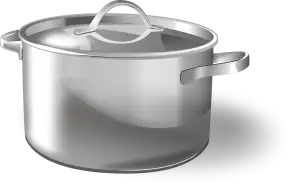Master the Art of Boiling Potatoes: Step-by-Step Instructions to Perfectly Cook Potatoes

- Step 1: Choose the right potatoes
- Step 2: Wash and peel the potatoes (optional)
- Step 3: Cut the potatoes into uniform pieces
- Step 4: Place the potatoes in a pot and add water
- Step 5: Add salt to the pot
- Step 6: Bring the water to a boil
- Step 7: Reduce the heat and simmer the potatoes
- Step 8: Check for doneness with a fork
- Step 9: Drain the potatoes
- Step 10: Serve and enjoy your perfectly boiled potatoes
- Tips for enhancing the flavor of boiled potatoes
Boiling potatoes is a fundamental cooking technique that every aspiring chef should master. Whether you're making mashed potatoes, potato salad, or simply enjoying boiled potatoes as a side dish, knowing how to cook them perfectly is essential. Boiling potatoes not only softens their texture but also enhances their natural flavors. In this article, we will guide you through the step-by-step process of boiling potatoes to achieve tender and delicious results every time. So grab your apron and let's get started on this culinary journey!
Step 1: Choose the right potatoes
When it comes to boiling potatoes, choosing the right variety is crucial. Look for potatoes that are high in starch content, such as Russet or Yukon Gold, as they tend to hold their shape well during cooking. These varieties also have a fluffy texture once boiled, making them perfect for mashing or roasting. Avoid waxy potatoes like red or new potatoes, as they can become mushy when boiled. Selecting the right potatoes will ensure that you achieve the desired texture and flavor in your dishes.
Step 2: Wash and peel the potatoes (optional)
Before boiling your potatoes, it is important to wash them thoroughly. This will remove any dirt or debris that may be present on the skin. If you prefer to keep the skin on, make sure to scrub the potatoes well.
Peeling the potatoes is optional and depends on personal preference. Some recipes call for peeled potatoes, while others recommend leaving the skin on for added texture and flavor. If you choose to peel them, use a vegetable peeler or a sharp knife to carefully remove the skin.
Remember, leaving the skin on can also provide additional nutrients and fiber. So, if you're looking for a healthier option or want to save time, consider keeping the skin intact. Ultimately, it's up to you and what suits your taste and recipe requirements.
Step 3: Cut the potatoes into uniform pieces
To ensure even cooking, it is important to cut the potatoes into uniform pieces. This will help them cook at the same rate and prevent some pieces from becoming mushy while others remain undercooked. Aim for roughly equal-sized chunks, about 1-2 inches in diameter. This will allow for a consistent texture and make it easier to gauge when they are done. Take your time with this step to ensure that each piece is cut to perfection.
Step 4: Place the potatoes in a pot and add water
Once you have prepared the potatoes, it's time to cook them. Take a large pot and place the cut potatoes into it. Make sure to choose a pot that is big enough to accommodate all the potatoes without overcrowding.
Next, fill the pot with enough cold water to cover the potatoes completely. The water should be at least an inch above the potatoes. This will ensure even cooking and prevent them from sticking to the bottom of the pot.
Adding enough water is crucial as it helps in creating steam which cooks the potatoes evenly. Also, using cold water instead of hot water ensures that the potatoes cook uniformly from inside out.
Remember not to add too much water as it can dilute the flavor of your potatoes. Aim for just enough water to cover them adequately.
Now that your potatoes are in the pot and covered with water, you're ready to move on to the next step: adding salt.
Step 5: Add salt to the pot
Once you have placed the potatoes in the pot and added water, it's time to enhance their flavor by adding salt. Salt not only adds taste but also helps to season the potatoes evenly.
For every 4 cups of water, add about 1 teaspoon of salt. You can adjust the amount according to your preference, but be careful not to overdo it as it can make the potatoes too salty.
Stir the water gently to dissolve the salt and ensure that it is evenly distributed. This will help in achieving a consistent flavor throughout the potatoes as they cook.
Remember that adding salt at this stage is crucial as it allows the potatoes to absorb some of its flavor while boiling. So don't skip this step if you want perfectly seasoned boiled potatoes that are bursting with taste.
Now that you have added salt, move on to step 6: bringing the water to a boil.
Step 6: Bring the water to a boil
Once you have added salt to the pot, it's time to bring the water to a boil. Place the pot on the stove over high heat and cover it with a lid. This will help the water come to a boil faster. Keep an eye on the pot as it heats up.
As the water starts to heat, you may notice small bubbles forming at the bottom of the pot. This is a sign that it is getting closer to boiling point. Be patient and wait for larger bubbles to appear, indicating that the water has reached its boiling point.
Avoid lifting the lid too often during this process, as it can cause heat loss and prolong the boiling time. However, if you notice that the water is about to overflow, reduce the heat slightly or partially lift the lid to release some steam.
Bringing the water to a boil is an important step in cooking potatoes as it helps soften them evenly and ensures they cook thoroughly. Once you see a rolling boil, move on to step 7 and continue simmering until your potatoes are tender and ready for your culinary creations.
Step 7: Reduce the heat and simmer the potatoes
Once the water has come to a rolling boil, it's time to reduce the heat and let the potatoes simmer. This gentle cooking method ensures that the potatoes cook evenly and become tender without falling apart.
Lower the heat to medium-low or low, depending on your stove's settings. You want a steady simmer, with small bubbles gently rising to the surface. Cover the pot partially with a lid to retain some of the steam and prevent too much evaporation.
Allow the potatoes to simmer for about 15-20 minutes, or until they are fork-tender. Keep an eye on them during this time to ensure they don't overcook and become mushy.
Simmering allows for a more controlled cooking process compared to boiling at high heat. It helps retain the shape and texture of the potatoes while infusing them with flavor from any seasonings added earlier.
Remember, different potato varieties may require slightly different cooking times, so adjust accordingly. To check for doneness, insert a fork into one of the potato pieces. If it easily goes through without resistance, your potatoes are ready!
By mastering this step, you'll achieve perfectly cooked potatoes that are soft yet firm enough to hold their shape in various recipes. So be patient and let them simmer away until they reach perfection!
Step 8: Check for doneness with a fork
To ensure your potatoes are perfectly cooked, use a fork to test their doneness. Gently insert the fork into one of the potato pieces. If it easily slides in and out without any resistance, your potatoes are done. They should be tender but not mushy.
If the fork meets any resistance or the potatoes feel firm, continue simmering them for a few more minutes and then check again. Be careful not to overcook them as they can become too soft and lose their shape.
Remember, different potato varieties may have varying cooking times, so it's important to keep an eye on them while simmering. Once they reach the desired level of tenderness, remove them from heat immediately to prevent overcooking.
Checking for doneness with a fork is a simple yet effective method to ensure your boiled potatoes are cooked to perfection every time.
Step 9: Drain the potatoes
Once the potatoes are tender and cooked to perfection, it's time to drain them. Carefully pour out the hot water from the pot using a colander or strainer. Make sure to hold onto the pot securely to avoid any accidents. Allow the excess water to drain completely, ensuring that the potatoes are dry before proceeding. This step is crucial as it prevents your dish from becoming watery and helps maintain the desired texture of the boiled potatoes. Now that your potatoes are drained, they're ready for the final step of serving and enjoying!
Step 10: Serve and enjoy your perfectly boiled potatoes
Once the potatoes are cooked to perfection, it's time to serve and savor their deliciousness. Carefully drain the water from the pot, ensuring all excess moisture is removed. Transfer the potatoes to a serving dish, and if desired, sprinkle some fresh herbs like parsley or chives on top for added flavor and visual appeal. Serve alongside your favorite main course or as a side dish. The creamy texture and delicate taste of these perfectly boiled potatoes will surely delight your taste buds. Enjoy!
Tips for enhancing the flavor of boiled potatoes
Published: 02. 12. 2023
Category: Food



